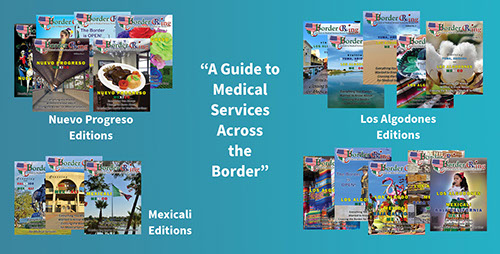DESTINATIONS IN México
STATE OF BAJA CALIFORNIA
Los Algodones
Mexicali
USA side Border Area/Towns
Yuma, Arizona
Imperial Valley, California
Destinations
Medical & Dental Services
Everything You Always Wanted to Know About Crossing the Border for Medical Services

ABOUT THE HISTORY OF LOS ALGODONES
Only a Century old,
the rich history of Los Algodones (“The Cottons”) is very hard to find, when you walk into Los Algodones today you see a small Mexican town with 350 dentists in a three by four block radius, which makes it the town with the most dentists per capita in the world, “Molar City” but how it came to be that town, is very interesting.
With the gold rush and more and more Immigrants heading to California, México needed to secure more land in the California area. The Mexican President gave large amounts of land to his family, friends and to many of his trusted military officers, claiming the territory as Mexican occupied. That is how retired General Guillermo Andrade came to be in Baja California.
He was given an area just a few miles south of the Yuma Crossing to encompass the area of the Mexicali Valley all the way south to the Gulf. Retired General Guillermo Andrade now needed labor to work the area so he brought farm hands from all over México to work his large ranch. They, the workers, were referred to as “the Andrade Cowboys”. Those cowboys later were settled in the town of Los Algodones, making Los Algodones the first settlement in the Mexicali Valley. Although the official year that Los Algodones was founded is in 1894.
They built homes somewhat scattered and close to the river. Los Algodones was actually founded in part of the mesa of Andrade and because of being settled next to the Colorado River, not far from Yuma, and next to the border, it was a town that at the beginning was very isolated, there was no connection to Yuma and it was way too far from everything else in México.
As the Colorado River started growing in a commercial way, as the “Gateway to the West”, with the steamboats that carried provisions to the west in California. Progress continued and soon the Southern Pacific Railroad opened a connection, through Los Algodones, to the West, in order to avoid the sand dunes. The railroad brought immigrants as labor, from all over including China and some of whom settled in and around Los Algodones. In 1878, the border line between the 2 countries was established. With the completion of the transcontinental rail systems, the steamboat era ended and the agricultural era began. The Colorado River soon gave way to building on the farming, growing cotton and vegetables in the area.
.jpg?crc=357129494)
During the prohibition era, Los Algodones saw its first tourism boom for the cantinas and bars. As Sandra, whom we interviewed, puts it: “Los Algodones was the official CANTINA OF THE VALLEY with 48 bars and very little of anything else here. The first block, coming from the border, was the train depot on the right and on the left was a parking lot for a cantina/restaurant, where Americans came for the burritos all the time, and next door on the corner was the gas station”.
With The United States occupied with World War II, there was a huge demand for farm labor, the train transported workers from all over México to work the fields in the U.S. on the Braceros Program. Mexicans, like Don Ramon Muñoz who worked as a Bracero, were hired to work in the fields and other handyman duties in The United States. Many Mexican-Americans trace their family’s roots in the US to their fathers’ or grandfathers’ arrival as braceros.
Morelos Dam, the last dam on the Colorado River, was built from 1948-50, it diverts its water from the Colorado River to highly developed crop lands in the Mexicali Valley. The Morelos dam brought jobs with good wages. Their Children would take the train every day from Los Algodones to Mexicali, to go to school every day.
By the 1950’s the railroad was gone and today the only remnants of the train station left in Los Algodones is the Mexican Government buildings you pass through on your way into the town of Los Algodones, within feet of the Andrade U.S. Port of Entry. Ramon Munoz and his wife Delia, Sandra’s in-law’s, owned the first General store in town that “sold everything from a needle to a saddle”.
Dentistry was pretty simple before 1969...if you had a toothache, pull the tooth out...if you had a cavity, fill it up. San Luis Rio Colorado, México was the closest dentist. Fresh out of the University of México City, visiting his brother in San Luis, Dr. Bernardo Magaña was persuaded to settle in Los Algodones as the first dental surgeon in the area. On his first day he saw 9 patients, and some days he would see as many as 100 patients. For 3 years he was the only dentist, he would work from 6am - 11pm most days.
So, when you walk into Los Algodones today you see a small Mexican town that has gone through many changes since it was first settled by ranch hands a long way from anywhere except the river, well over a 100 years ago. Now with around 350 dentists in a three by four block radius it is growing to be an easily, well sought after medical tourism destination with an average 3,000 visitors a day and growing. Come see the charm that brings many a tourist back year after year.
Back to the Top
Copyright © 2023 Border CRxing All Rights Reserved


